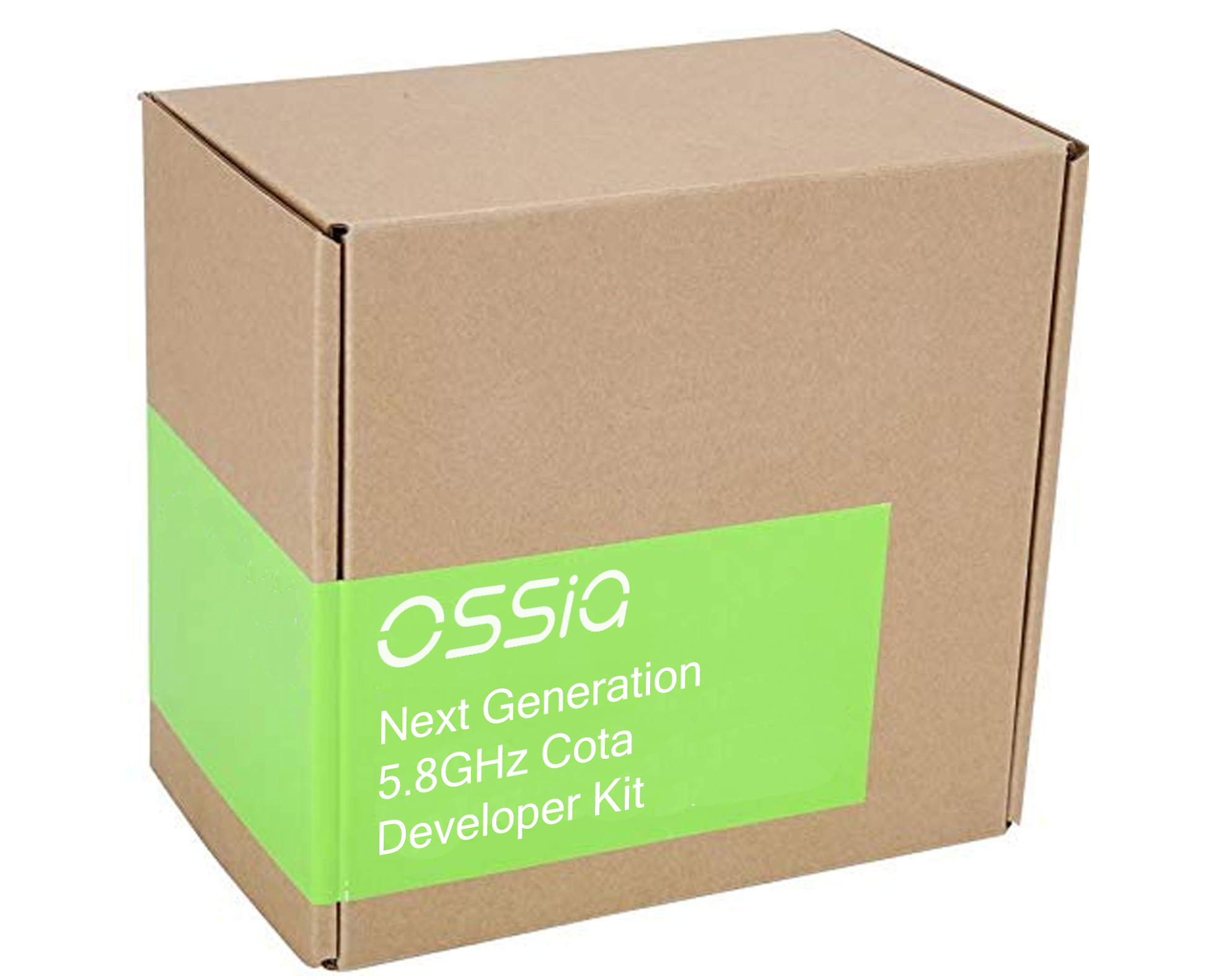Ossia Unveils Next-Gen, 5.8-GHz Wireless Power (But Where's the First Gen?)
The company has a new developer kit, but consumers are still waiting for shipping products.
All of the radio waves and signals bouncing around you can be boiled down to a single thing: energy. Sure, they may carry Wi-Fi or sound, they may connect our cell phones or bring us the latest Harry Styles tunes, but they’re all essentially energy. And as such, they should be able to provide not just entertainment but electricity, right?
That’s the promise of Ossia and other wireless technology companies, and unfortunately, it’s always been more promise than practice. Tom’s Hardware first introduced you to Cota wireless power in 2015, and the technology has yet to explode. But at CES 2023, Ossia is doing all it can to make it easy to develop actual products that deliver on that promise, with the new Cota 5.8-GHz Real Wireless Power developer kit.

At the show, Tom’s Hardware sat down with Hatam Zeine, the inventor of the technology, to discuss when and where we’ll see the technology. Spoiler: It’ll probably show up in businesses before you can get one for yourself. But later this year or maybe early next year, we’ll see at least some devices that use the technology.
Zeine described to us double-A shaped devices that can replace batteries in, say, your smoke detector or remote control and use the company’s wireless power. Or better yet, a Qi charger that is itself wirelessly charged, so you can simply drop it on the bedside table and charge your phone. “This is coming soon,” we asked?

“That’s coming! This is coming now!” Zeine said, though he quickly noted that he was unable to speak for which 3rd party would be supplying it. Or those charging pads. But they’re coming! And at Mobile World Congress, the company will be taking pre-orders for a new universal base that can be retrofitted into other devices and the new Archos camera that supports the tech.(At last, some people might say!)
The new developer kit will let curious manufacturers try out wireless power for themselves, to see how Ossia’s tech can fit into their devices. And with the array of wireless cameras, doorbells, smart lightbulbs, and other such gadgets growing by the day, the potential for wireless power to keep them all fully charged, all the time is immense.
To be clear the technology works. Ossia’s breakthrough relies upon a principle in physics known as retrodirectivity. Using this technology, a tiny chip embedded in a device sends a signal to a base station, a flat, thin panel that resembles a notepad on a stand. It uses either a 2.4-GHz signal or a 5.8-GHz frequency to transmit energy wirelessly back to the receiver chips, which can be built into anything: smartphone cases, laptops, lamps, you name it. There’s no line of sight required, and zero interference with Wi-Fi and Bluetooth signals, the company promises.
Get Tom's Hardware's best news and in-depth reviews, straight to your inbox.
“Our technology is basically utilizing a large array of antennas that can focus their energy into a specific device in the environment,” Zeine explained.
But getting manufacturers to integrate the receiver chips into their devices has been the real hurdle for Ossia. Not to mention safety certification from the FCC. In 2020, CEO Mario Obeidat pointed Tom’s Hardware to FCC certification that the Cota transmitter and receiver acquired in June for working at 2.4 GHz at a distance of up 1m. The Cota was certified for almost 1W, Obeidat said, but the transmitter could go up to 2-3W. In March, the FCC lifted that distance limit: Beam your signals as far as you’d like, the agency essentially said. It’s safe. But 5.8 GHz signals, which can charge much more rapidly albeit over shorter distances, remain an elusive target.
5.8 GHz isn’t necessary for Ossia, Zeine told Tom’s Hardware. But it means the company won’t have to dance around the Wi-Fi signals that clutter the 2.4 GHz bandwidth, opening up possibilities and bringing higher power charging. Wireless power may just be the future after all.

After 25 years covering the technology industry, Jeremy Kaplan is a familiar face in the media world. As Content Director for Tom's Hardware, he oversees product development and quality. He was formerly Editor in Chief of Digital Trends, where he transformed a niche publisher into one of the fastest growing properties in digital media. Before that, he spent half a decade at one of the largest news agencies in the world, and cut his teeth in magazine business, long before the birth of the iPhone. In 2019, he was named to the FOLIO: 100, which honors publishing professionals making an industry-wide impact.
-
jkflipflop98 Yet 100 years ago Mr. Tesla could light up a lightbulb from a mile away.Reply
Sure would be cool to have another Mr. Tesla show up. -
Exploding PSU I'm totally clueless when it comes to this kind of tech, but I wonder if it would interfere with microwaves? I know my home wireless network dies whenever the microwave is on.Reply -
Wrss Reply
Think that was only across a stage or room, using EM induction.jkflipflop98 said:Yet 100 years ago Mr. Tesla could light up a lightbulb from a mile away.
Sure would be cool to have another Mr. Tesla show up.
The company in the article seems instead to use a phased array radar, which is how jet fighter nose cones conduct pencil beam searches. Energy transmission this way is still quite inefficient. If you thought Qi/induction got hot... now add everything that heats up in a microwave oven.
Not every Tesla idea would gain traction. He got stuff wrong - didn't realize certain hertz ranges bounced off the atmosphere, didn't want to admit resistance still dampens AC transmission, just as a 5-pound oscillator won't drop a building. But that's the price of research, and he did get us AC and induction motors sooner than otherwise. Could use more brilliant curious minds like his. -
I don’t know. An F-35 can fry enemies ground based radar with its AESA radar. I’m not too sure how inefficient they are anymore.Reply
-
bill001g The strange comment is they think it doesn't interfere with wifi when wifi overlaps all the 5.8 radio band. Also it depends on exactly which part of the band they are talking about.Reply
Even if the fcc changed the transmit power allowed in the USA almost all the 5.8 band is not allowed in many countries including canada. Large parts are also not allowed in the EU or limited to say 25mw which is not going to charge very fast. -
lmcnabney The key question is how many watts are consumed at the transmitter to provide those 5 watts at the receiving end.Reply
I'm sure that burning 100-200 watts to trickle-charge a phone across the kitchen isn't going to go over very well. I could see some medical uses though. -
mac_angel I don't see why people just don't fast-charge their devices in the microwave. It would be a lot faster, and almost everyone has a microwave already.Reply
Jokes aside, I'm not completely sure how the technology works, but if it's just picking up wireless signals at 2.4GHz and 5.8GHz, I kinda have to wonder if a transmitter would really be needed. Most places are already saturated with these radio signals. Would it be possible just to figure out a receiver that can just take energy out of all the existing signals out there? You're not talking about it needing to have data encryption and security, just be able to take energy from those radio waves. -
TJ Hooker Reply
I'm interested in reading more about this, do you have a source?Mandark said:An F-35 can fry enemies ground based radar with its AESA radar. -
TJ Hooker Reply
The power flux density (power per unit area) you'd get from existing source (e.g. routers) is too low. You need a highly directional antenna (array) to focus the power to the area/device you want to charge.mac_angel said:but if it's just picking up wireless signals at 2.4GHz and 5.8GHz, I kinda have to wonder if a transmitter would really be needed. Most places are already saturated with these radio signals. Would it be possible just to figure out a receiver that can just take energy out of all the existing signals out there? You're not talking about it needing to have data encryption and security, just be able to take energy from those radio waves. -
Endymio Reply
Why not?" The utility of a 100w wireless charging base certainly outweighs the utility of a 600w graphics card.lmcnabney said:I'm sure that burning 100-200 watts to trickle-charge a phone across the kitchen isn't going to go over very well.